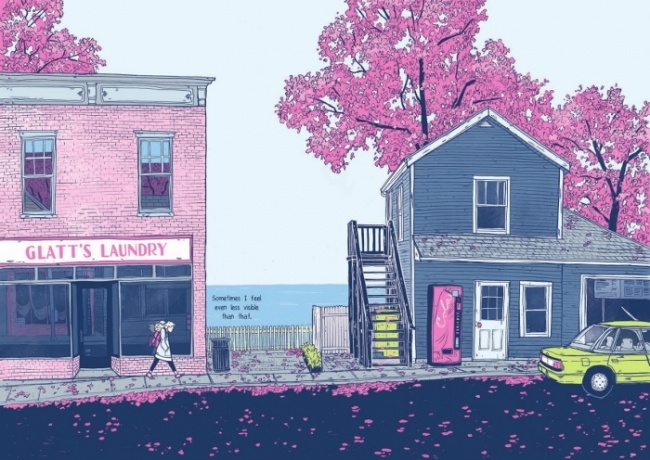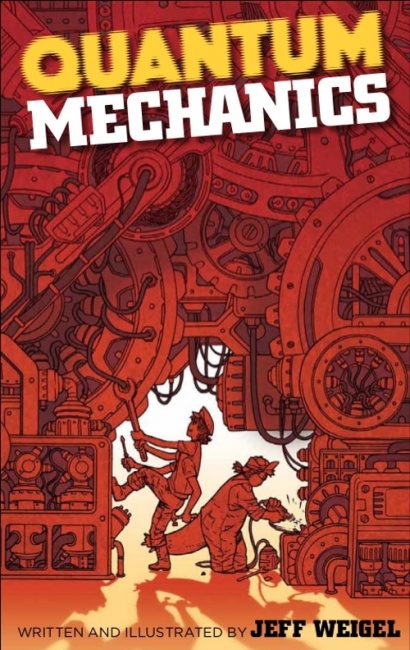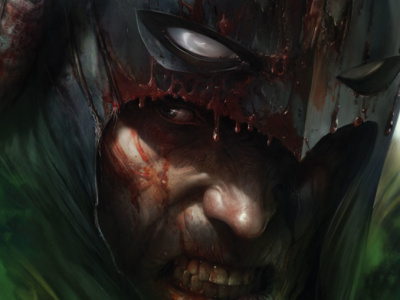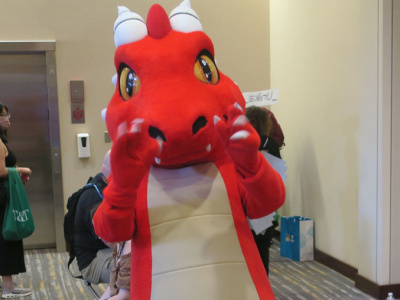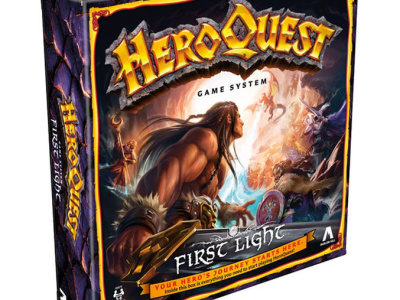ICv2: What’s your general assessment of the market for kids/teens comics right now?
Colvin: The market for kids and teen comics, it seems to me, is exploding. I feel like we are really on the cusp of much, much greater acceptance.
I think you see this a lot with the kids' gatekeepers like teachers and librarians, not all of them, but certainly much more than when we started even six years ago with AMP comics for kids are not only accepting the comic format but they're looking really excited about it.
That is starting to drip over to parents as well, the other gatekeepers. I also think those kids who, when they were younger, read Raina Telgemeier's Smile and are now teens, are much more open to the comics format, in a way that a lot of the audience of books like Nimona and Lumberjanes.
I think we are getting there. You often hear from older kids and some adults that, say, don't read comics, because they have trouble with them and they don't really know how to read them, so I do think it's really important to get comics in front of kids as young as you can. We are also doing CubHouse picture books, comics‑inspired picture books.
I think comics aren't just an alternate format. They actually teach visual literacy in a way that reading prose doesn't. There is a whole other value you can get out of comics.
In my opinion, they should be taught and read and given to kids and teens alongside prose fiction and nonfiction.
The market for kids and YA's graphic novels has been viewed, based on sales, as primarily book‑channel or library‑targeted, in terms of where the primary opportunities are. Is that where you see the opportunities or do you see that expanding into the comic stores?
I definitely agree that is where the primary opportunities are.
There's definitely some expansion into comic stores. This is very circumstantial evidence, but I spend a fair amount of time in comic stores.
They're all obviously trying to bring in the kid reader and make comfortable spaces for kids comics and teen comics too. It's a really interesting market, the comic store.
Some of them are having more success than others. Really, it's going to depend on individual stores and proprietors and how they market to kids and make their spaces fun, happy, safe spaces for kids to go and shop and learn.
Most parents still have this view of the comic shop as something from the nineties, where it's like dudes smoking pot in the back and pictures of women busting out of chainmail bikinis all over the place. Unless they themselves grew up reading comics, they're not necessarily going to take their kids to those stores.
Adoption in the libraries especially, but now the trade market, have definitely been the driving force. I'd love to see the direct market get there and do more with kids' books. It's a real opportunity.
One of the things they struggle with, which traditional bookstores have a lot more experience with than comic stores, is age segmentation. Tell us a little bit about the age segmentation between CubHouse and Roar and how that leads to merchandising in the store in terms of the target audience and how they organize things.
The direct market has this term that they call "All Ages." Instead of the Kids' Section, they call it the All-Ages section. To me, All-Ages is like a movie. It's like Toy Story. It means that yes, it's OK for kids, but it's got something in there for adults too.
We feel strongly that the books need age ranges, because parents need to know what is appropriate for their kids.
CubHouse goes up to age 12. The picture books obviously, in a lot of cases, will be younger. They'll be three to seven, because a lot of those are read‑alouds and not necessarily self‑reads.
Once you get into self‑read, CubHouse is really the 7‑to‑12 age range. That's altogether. We'll have books and we'll say, "This is best for ages 7 to 10," or, "This is best for ages 10 to 12."
So you're even breaking it down more finally within those imprints.
Yeah, it depends on the book. I want to have as broad a range as possible, because kids come to reading from so many different places and their reading levels can be so different. I don't want to say that a 7‑year‑old and a 12‑year‑old won't read, enjoy and get a lot out of the same book.
But there are topics that really change, I think, when you switch over from younger to middle‑grade readers and to teen and young adult. I do think it's important to broadcast that these are for a different, slightly older audience.
For instance, kids books might have crushes, but there's no romance. Whereas teens are extremely interested in romance. Things can be a little darker for teens too, even though younger kids do like dark and scary situations as well. Harry Potter is considered a middle‑grade book.
Your reference to All-Ages as a term also resonated because you're acquiring BD [bandes dessinees, Franco Belgian comics]. We hear that from the French publishers a lot, "Well, this is for all ages," which drives the American people that are trying to market it nuts, because they don't know who to sell it to. Tell us about your acquisition of BD and how you decide how to target that.
A lot of the BD stuff that we are acquiring now, part of it is honestly because we're a new publisher. It takes time and work to develop original content. So we're looking to that market for appropriate, good, fun‑to‑read, really beautiful, in a lot of cases, content that we can quickly bring to market.
But I've got to tell you, we've had a whole lot of internal discussions about some… I guess I would say that Americans are not French by any stretch of the imagination. We can be a little prudish. [laughs]
I'm probably a good example of an American who can be a little prudish. We'll look at something that in all other ways is totally appropriate to 9‑ to 12‑year‑olds, but it's got a sexy minute. [laughs]
In a lot of cases, we'll have to figure out, "OK, well is there an older audience who is also going to get a lot out of this book?" If so, that's who we need to market it to.
Or something that is really kind of existential and philosophical, but the characters are drawn in a way that we, as Americans, would see as appealing more to younger readers. In fact, it's a book for adults. The subject matter is a book for adults.
Honestly, it's a challenge to figure out how to market those things. You'll probably see them all over our list. In a lot of cases, we are going back and asking the publishers or their creators to tone down some images, if we think otherwise they are appropriate for kids, but there are naked breasts in them.
Or even smoking. Tintin has got some smoking in it and some people say it makes it inappropriate for younger readers.
Yeah, the colonialism and the racism in Tintin might also [make it inappropriate], right?
[laughs] Well, there's that.
We don't always think of that. I know. It's interesting. We have gotten really particular with the kind of content that will put in front of our younger readers.
I personally grew up reading Tintin and Elfquest, which has got naked orgies in it, which was extremely titillating for me, when I was a kid.
But if you think about what Mickey Mouse cartoons looked like 50 years ago and what they look like now, everything has become really sanitized. We are dealing with gatekeepers; we're not selling directly to nine‑year‑olds. We are selling to their teachers, their parents and their librarians.
I think it's important that they are able to trust our content. Also, I don't feel strongly that small kids should be able to see smoking and sex. I think there's plenty enough time for that in their lives too.
There are so many discussions about whether kids should read up or not, but that's a whole other rabbit‑hole.
How many titles are you going to put out this year in those two imprints?
Oh, good question. I think this year we will probably get up to maybe 20 or 30. Next year we are hoping to do more, maybe 40 or 50, combined between the two.
This year, we're doing a lot of work now, because we're doing the European imports, while, at the same time, working really hard on developing a lot of original stuff that we'll be publishing in 2018 and 2019.
We've got a lot of really awesome stuff that hasn't been announced yet. We are still in contractual negotiations on a lot of stuff.
I think you'll see the title stock shift a lot more toward fun, original, a lot of American creators, a lot of indie creators too doing stuff that's very kid‑friendly, very fun. I really want to do and have acquired a number of memoir and nonfiction comics and graphic novels.
It is my thought and I think obviously some other people's thought too, that that is a really fertile area of the market for both kids and teen comics, that we are really just scratching the surface of right now. So I think we'll be doing a lot of those as well.
Are you talking about things like Lighter than My Shadow (see "Memoir of Tough Teen Years"), which is not a person that we would have known previously, or something like March, which obviously is a memoir of a very famous person?
We're going to be doing both. Lighter than My Shadow obviously is a memoir from a person we wouldn't have known previously.
We do have a few other personal memoir graphic novels in the Roar imprint that we're in the process of signing up. These are sort of like the Raina Telgemeier style. We all know a lot about her orthodontia now, but we didn't know about her before Smile came out.
But we are also going to be doing graphic novels, biographies of famous figures. We have some announcements about that that hopefully we'll be able to make in the next month or so.
We’ve covered a number of your 2017 Roar and CubHouse announcements (in addition to the link above, see "Roar Comics Shares Details on First YA OGNs for 2017" and "Lion Forge Adds Two to CubHouse Line"). Where are the biggest opportunities among those titles?
Little Red Wolf is definitely one of my favorites. It's got just amazingly gorgeous art. It's one of the most beautiful books I've ever seen, plot aside.
The plot is awesome, because it turns the Little Red Riding Hood story on its head. It's clever. It's unique. It makes kids think about things from a different angle. Also I think the art will appeal to all sorts of different people. I'm excited about that.
Water Memory is one that I really love too. I think it's probably most like the original publishing that we'll be doing in 2018 and beyond.
It starts off with an Amulet‑esque premise: young girl moves with her mother after a tragedy to an old family house but it's got secrets.
But it goes in a really different direction. As far as the fantastical stuff, that's the kind of thing I'm really interested in and excited about. God, I wish I had more of that.
We have so many that are the middle of negotiations and not totally signed yet. I wish I could tell you about more stuff, because... oh wait.
I had signed up a graphic adaptation of Anne of Green Gables at Andrews McMeel that they are going to be publishing this fall, very fortuitously, in time for the new Netflix adaptation of the book.
I have just signed up Brenna's first original graphic novel. It's a really sweet, middle‑grade story of a young girl, Marjorie, just trying to get over her mother's death and figure out her place in the world. But it also has ghosts.
The cool thing about these ghosts is that they wear sheets. You can't see them without the sheets and Marjorie runs a laundromat.
Brenna's got such a really sweet atmospheric style. I'm really, really excited for that too. (see "Exclusive Preview: 'Sheets' GN by Brenna Thummler").
Then another one that will also be in 2018 is called Quantum Mechanics from Jeff Weigel.
I had published his Dragon Girl. It was one of our first AMP Kids acquisitions at Andrews McMeel. We didn't do it in color, which was a mistake, I've since realized. Anything for kids ‑‑ always color. Always color.
But this one is even better. It sees scrappy alien mechanic young girls who are kidnapped by this pirate ship.
But are the pirates really that bad? There's corporate galactic intrigue and cute little space gremlins. It's really fun. (see "Exclusive Preview: 'Quantum Mechanics' GN by Jeff Weigel").
Anything else you want to communicate to our readers about what's going on at Roar and CubHouse?
Well, I think I'm probably just reiterating everything, something that people already know about Lion Forge but just how much we are committed to telling stories about diverse people from diverse perspectives. That can mean almost anything, any sort of diversity.
Also, really telling authentic stories is really important to us, even if they are authentic space adventures. It's still really important that our stories have that real sparkle and that real authenticity that helps kids really identify with the characters, even if they're green and purple space aliens.
Really, particularly with CubHouse and Roar, what we want to do is foster a love of reading, because it's just so important that we don't put down books when we grow up. Books can be fun as well as something that shows us that there are other people in the world like us.
Lighter Than my Shadow ‑‑ one of the things that is so great about that book is that I think there are probably other people in the world who are going to be able to identify with Katie Green's experience or part of her experience and, because of it, realize that they're not alone the way Katie thought she was. That is a really important thing, I think, for us to do with these books.





